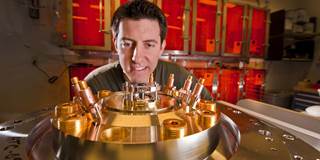Even if world leaders reach an agreement at the UN climate conference in December to reduce greenhouse-gas emissions substantially by 2050, the question of how to meet a booming global population’s insatiable appetite for energy in the longer term will remain. One of the most promising options is nuclear fusion.
LONDON – This December, world leaders will gather in Paris for the United Nations Climate Change Conference, where they will attempt – yet again – to hammer out a global agreement to reduce greenhouse-gas emissions. Despite the inevitable sense of déjà vu that will arise as negotiators struggle to reach a compromise, they must not give up. Whatever the political or economic considerations, the fact remains: if global temperatures rise more than 2˚C from pre-industrial levels, the consequences for the planet will be catastrophic.
But the challenge does not end with reducing emissions. Indeed, even if we make the transition to a cleaner world by 2050, we will need to determine how to meet a booming global population’s insatiable appetite for energy in the longer term – an imperative that renewables alone cannot meet. That is why we need to invest now in other technologies that can complement renewables, and provide reliable electricity for many centuries to come. And one of the most promising options is nuclear fusion – the process that powers the sun and all stars.
Brought down to earth, nuclear fusion – a process fueled primarily by lithium and deuterium (an isotope of hydrogen), both of which are plentiful in seawater and in the earth’s crust – could provide a major source of low-carbon energy. A fusion power station would use only around 450 kilograms of fuel annually, cause no atmospheric pollution, and carry no risk of accidents that could lead to radioactive contamination of the environment.

LONDON – This December, world leaders will gather in Paris for the United Nations Climate Change Conference, where they will attempt – yet again – to hammer out a global agreement to reduce greenhouse-gas emissions. Despite the inevitable sense of déjà vu that will arise as negotiators struggle to reach a compromise, they must not give up. Whatever the political or economic considerations, the fact remains: if global temperatures rise more than 2˚C from pre-industrial levels, the consequences for the planet will be catastrophic.
But the challenge does not end with reducing emissions. Indeed, even if we make the transition to a cleaner world by 2050, we will need to determine how to meet a booming global population’s insatiable appetite for energy in the longer term – an imperative that renewables alone cannot meet. That is why we need to invest now in other technologies that can complement renewables, and provide reliable electricity for many centuries to come. And one of the most promising options is nuclear fusion – the process that powers the sun and all stars.
Brought down to earth, nuclear fusion – a process fueled primarily by lithium and deuterium (an isotope of hydrogen), both of which are plentiful in seawater and in the earth’s crust – could provide a major source of low-carbon energy. A fusion power station would use only around 450 kilograms of fuel annually, cause no atmospheric pollution, and carry no risk of accidents that could lead to radioactive contamination of the environment.